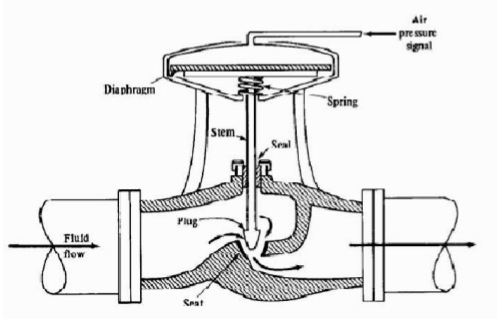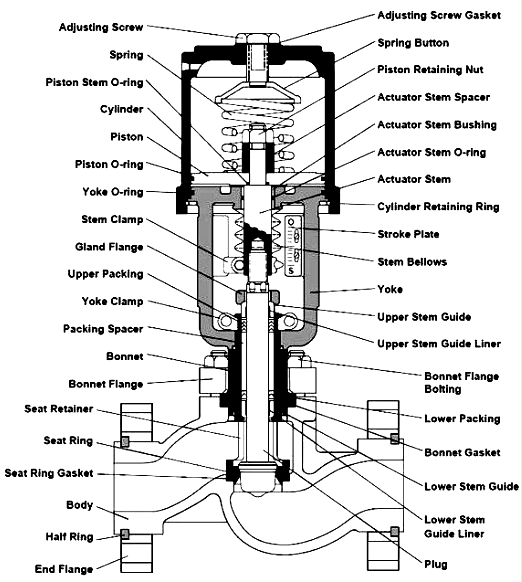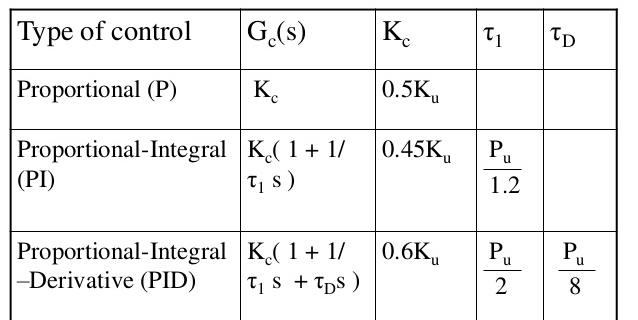Control Valve blog contains
- Introduction
- Parts of Control Valve
- Air-To-Open vs. Air-To-Close
- Failure Mode
- Controller Tuning
- Tuning Rules
Introduction
A valve in which the force of compressed air against a diaphragm is opposed by the force of a spring to control the area of opening for a fluid stream.
It consist of an actuator and a valve.
The actuator moves the valves stem as the pressure on a spring loaded diaphragm changes.
Parts of Control Valve
A valve is a mechanical device that controls the flow of fluid and pressure within a system or process. A valve controls system or process fluid flow and pressure by performing any of the Following functions.
a) Stopping and starting fluid flow
b) Varying (throttling) the amount of fluid flow
c) Controlling the direction of fluid flow
d) Regulating downstream system or process pressure
e) Relieving component or piping over pressure
There are many valve designs and types that satisfy one or more of the functions identified above. A multitude of valve types and designs safely accommodate a wide variety of industrial applications.
Basic Parts of Control Valves
Regardless of type, all valves have the following basic parts: the body, bonnet, trim (internal elements), actuator, and packing. The basic parts of a valve are illustrated in Figure
Control valve having basic two parts
1. Actuator Part
2. Body Parts
1. Actuator Part
For valve control, it will be classified as either a Phenumatic,
Motorized and Hydrolics but is commonly used in our industry, it is Phenumatic Actuator Actuator or controlled by the wind itself. For easy maintenance Actuator simple structure which will include the Yoke, too.
Various components of the Actuator
Rain Cap
I pray for them not to let water flow into the Actuator for Action of the Air to Open Actuator is that the wind will be from the bottom of the Actuator so the holes are left blank.
Find something else to disabled To keep water when it rains. And must be taken off the air valve at the back.
Eye Bolt for use on the hook. Moving the valve.
Diaphragm is flexible. To change the incoming wind power and power passed to Diaphragm plate to make Actuator Stem Cell.
Spring is in the Yoke Actuator Case or, depending on the design of the manufacturer. It will act as a force for Actuator Stem Cell and a strong wind from the opposite direction to the plate Diaphragm.
Actuator Stem is interconnected with Actuator Valve Stem.
Diaphragm Case are the parts that are used for packing Diaphragm plate consists of two parts: the upper and lower sections.
Scale Plate is based on the position of the valve between 0-100%.
Stem Connector is the link between them for Actuator Stem and Plug Stem.
Yoke is a component that is used for connecting sections of the Actuator and Valve Body.
2. Body Part
Part of Body Valve is included in the Bonnet valve with which this segment is exposed to the fluid (fluid) directly, so choosing the required qualifications material (material) as well as Fluid type, Temp, Pressure and. etc
Packing Flange is used for compression of the stud bolt to make the most of all the Gland Packing tight and fluid can not leak out of the neck Bonnet.
Packing Follwer is the strength of Packing Flange Gland Pakcing tightly compressed to tighten over time.
Yoke Claim Nut
Gland Packing is important that we prevent the leakage of fluid up to the neck and is in direct contact with Bonnet Plug Stem The choice of material and type to fit so there is a huge need.Most of the material used is PTFE or Graphite and maintenance each time. The need to change the Gland Packing all times.
Valve Stem is the strength of the Actuator and connected to Plug.
Bonnet was primarily used for supporting the position of the Plug-time scroll up, scroll down to find it. No left and right But some manufacturers cut output to reduce the Bonnet Cost for the production and sale of the valve. The maintenance is also difficult. It is not to come and support the position of the Plug and Seat to meet constantly Lapping.
Stud Bolt and Nut
Gasket is a device used to prevent leaks during the assembly of iron and steel as well as between the Body and Bonnet.
Guide Ring is located in Bonnet order to align Plug straight up. Another reason for having Guide Ring Bonnet, instead of doing all the reason to reduce maintenance time Cost. Because this section is always exposed to Stem Plug sometimes wear if not Guide Ring may be a whole instead of only replacing Bonnet Guide Ring.
Guide Bushing is used for supporting Guid Ring again.
Valve Plug is essential to use the force of fluid flow. And determine the flow properties as Linear, Equal Percentage or Quick Openning.
Seat Ring is a component that is part of Valve Body and given the size of the Rated Cv of the valve and which supports Plug and Plug and Seat Ring must be close together. To be able to follow the Class Leakage as needed.
Valve Body , a major component of the round and get direct contact with the fluid. The connection to the pipeline Therefore, the size and material must be chosen accordingly. Read more at PT Rating by Valve Body structure is a frequently encountered 1. Single-Ported is a 1 plug with 1 seat 2. Double-Ported is a 2 plug with 2 Port 3. Two-Way Valve is. There will be two connections (one inbound and one outbound) 4. Three-Way Valve is to have three connections (one or two inbound and two outbound, inbound and one outbound).
Trim Set the control valve (Trim Control Valve) is the word of Plug Stem Seat Ring, which collectively set trim (trim set) itself.
Positioner or position will be the key to control of the control valve. The industry standard device that converts the signal (signal standard), such as 4-20 mA, 3-15 psi as wind power to propel Actuator head movements.
Valve Body
The body, sometimes called the shell, is the primary pressure boundary of a valve. It serves as the principal element of a valve assembly because it is the framework that holds everything together.
The body, the first pressure boundary of a valve, resists fluid pressure loads from connecting piping. It receives inlet and outlet piping through threaded, bolted, or welded joints.
Valve bodies are cast or forged into a variety of shapes. Although a sphere or a cylinder would theoretically be the most economical shape to resist fluid pressure when a valve is open, there are many other considerations.
For example, many valves require a partition across the valve body to support the seat opening, which is the throttling orifice. With the valve closed, loading on the body is difficult to determine. The valve end connections also distort loads on a simple sphere and more complicated shapes.
Ease of manufacture, assembly, and costs are additional important considerations. Hence, the basic form of a valve body typically is not spherical, but ranges from simple block shapes to highly complex shapes in which the bonnet, a removable piece to make assembly possible, forms part of the pressure-resisting body.
Narrowing of the fluid passage (venturi effect) is also a common method for reducing the overall size and cost of a valve. In other instances, large ends are added to the valve for connection into a larger line.
Valve Bonnet
The cover for the opening in the valve body is the bonnet. In some designs, the body itself is split into two sections that bolt together. Like valve bodies, bonnets vary in design. Some bonnets function simply as valve covers, while others support valve internals and accessories such as the stem, disk, and actuator.
The bonnet is the second principal pressure boundary of a valve. It is cast or forged of the same material as the body and is connected to the body by a threaded, bolted, or welded joint. In all cases, the attachment of the bonnet to the body is considered a pressure boundary. This means that the weld joint or bolts that connect the bonnet to the body are pressure-retaining parts.
Valve bonnets, although a necessity for most valves, represent a cause for concern. Bonnets can Complicate the manufacture of valves, increase valve size, and represent a significant cost portion of valve cost, and are a source for potential leakage.
Valve Trim
The internal elements of a valve are collectively referred to as a valve’s trim. The trim typically includes a disk, seat, stem, and sleeves needed to guide the stem. A valve’s performance is determined by the disk and seat interface and the relation of the disk position to the seat.
Because of the trim, basic motions and flow control are possible. In rotational motion trim designs, the disk slides closely past the seat to produce a change in flow opening. In linear motion trim designs, the disk lifts perpendicularly away from the seat so that an annular orifice appears.
Disk and Seat
For a valve having a bonnet, the disk is the third primary principal pressure boundary. The disk provides the capability for permitting and prohibiting fluid flow. With the disk closed, full system pressure is applied across the disk if the outlet side is depressurized.
For this reason, the disk is a pressure-retaining part. Disks are typically forged and, in some designs, hard-surfaced to provide good wear characteristics. A fine surface finish of the seating area of a disk is necessary for good sealing when the valve is closed. Most valves are named, in part, according to the design of their disks.
The seat or seal rings provide the seating surface for the disk. In some designs, the body is machined to serve as the seating surface and seal rings are not used. In other designs, forged seal rings are threaded or welded to the body to provide the seating surface.
To improve the wear-resistance of the seal rings, the surface is often hard-faced by welding and then machining the contact surface of the seal ring. A fine surface finish of the Seating area is necessary for good sealing when the valve is closed. Seal rings are not usually considered pressure boundary parts because the body has sufficient wall thickness to withstand design pressure without relying upon the thickness of the seal rings.
Stem
The stem, which connects the actuator and disk, is responsible for positioning the disk. Stems are typically forged and connected to the disk by threaded or welded joints. For valve designs requiring stem packing or sealing to prevent leakage, a fine surface finish of the stem in the area of the seal is necessary. Typically, a stem is not considered a pressure boundary part.
Connection of the disk to the stem can allow some rocking or rotation to ease the positioning of the disk on the seat. Alternately, the stem may be flexible enough to let the disk position itself against the seat. However, constant fluttering or rotation of a flexible or loosely connected disk can destroy the disk or its connection to the stem.
Two types of valve stems are rising stems and non-rising stems. These two types of stems are easily distinguished by observation. For a rising stem valve, the stem will rise above the actuator as the valve is opened. This occurs because the stem is threaded and mated with the bushing threads of a yoke that is an integral part of, or is mounted to, the bonnet.
There is no upward stem movement from outside the valve for a non rising stem design. For the non rising stem design, the valve disk is threaded internally and mates with the stem threads.
Valve Actuator
The actuator operates the stem and disk assembly. An actuator may be a manually operated hand wheel, manual lever, motor operator, solenoid operator, pneumatic operator, or hydraulic ram. In some designs, the actuator is supported by the bonnet. In other designs, a yoke mounted to the bonnet supports the actuator.
Except for certain hydraulically controlled valves, actuators are outside of the pressure boundary.Yokes, when used, are always outside of the pressure boundary.
Valve Packing
Most valves use some form of packing to prevent leakage from the space between the stem and the bonnet. Packing is commonly a fibrous material (such as flax) or another compound (such as teflon) that forms a seal between the internal parts of a valve and the outside where the stem extends through the body.
Valve packing must be properly compressed to prevent fluid loss and damage to the valve’s stem. If a valve’s packing is too loose, the valve will leak, which is a safety hazard. If the packing is too tight, it will impair the movement and possibly damage the stem.
Actuator Working
Actuator converts the command signal from controllers or higher-level components into physical adjustment in adjustable process variable.
It convert controller output signal (4-20 mA or 3-15 psig) to physical adjustment in the process input variables.
For process control, the most common type
of actuator is the control valve.
• Others include
- Variable speed pumps
- Hydraulic actuators
Actuator power
- Pneumatic: simple, low cost, fast, low torque
- Electric: motor and gear box, high torque, slow
- Hydraulic: high torque, fast, expensive
- Actuator Fluids
- Air
Oil (mineral and synthetic) which is Clean & Moisture Free
Air-To-Open vs. Air-To-Close
Air-to-Open (+ gain)
More air ->larger opening → No air → Valve closes.
Air-to-Close (- gain)
More air smaller opening → No air → Valve opens completely.
• Proper type to use is determined from safety considerations
• Air-to-close: Coolant valve in an exothermic reactor or in a condenser of a distillation column.
• Air-to-open: Steam valve in a reactor, inlet flow valve to a tank.
Failure Mode
Valve+Actuator
- Valve opening is adjusted by an actuator
• Pneumatic Control Valve
- Usually 3*15 psig signal is provided.
-1/P transmitter converts 4-20mA signal to 3-15 psig pneumatic signal via 20psig supply air.
Useful definitions
• Cycle time –
Also known as duty cycle; the total length of time for the controller to complete one on/off cycle.
Example: with a 20 second cycle time, an on time of 10 seconds and an off time of 10 seconds represents a 50 percent power output. The controller will cycle on and off while within the proportional band.
• Proportional band - A temperature band expressed in degrees (if the input is temperature), or counts (if the input is process) from the set point in which the controllers' proportioning action takes place.
The wider the proportional band the greater the area around the set point in which the proportional action takes place. It is sometimes referred to as gain, which is the reciprocal of proportional band.
• Integral, also known as reset, is a function which adjusts the proportional bandwidth with respect to the set point, to compensate for offset (droop) from set point, that is, it adjusts the controlled temperature to set point after the system stabilizes.
• Derivative, also known as rate, senses the rate of rise or fall of system temperature and automatically adjusts the proportional band to minimize overshoot or undershoot.
Controller Tuning
• The adjustment of control parameters to achieve satisfactory control is called Tuning.
• The process of tuning can vary from trial-and-error to an elaborate optimization calculation.
•A typical criteria for good control is that the response of the system to a step change in set point or load should have minimum overshoot and one quarter decay ratio.
Selection of controller modes
•P (Proportional Control)
• PD (Proportional Derivative Control)
• PID (Proportional Integral Derivative Control)
Load response of typical control system using various modes of control
Tuning Rules
Ziegler - Nicholas Rules (Z - N)
It's a closed loop tuning system as the controller remains in the loop as an active controller in automatic mode.
1. After the process reaches a steady state at normal level of operation, remove integral and derivative modes of controller, leaving only proportional control.
On some PID controllers this requires that the integral time () be set to its maximum value and derivative time (to) to its min. value.
2. Select a value of proportional gain (K), disturb the system and observe the transient response. If the response decays select a higher value of K and again observe the response of the system.
Continue increasing the gain in small steps until the response first exhibits a sustained oscillation.
The value of gain and period of oscillation that correspond to the sustained oscillation are the ultimate gain (Kcu) and ultimate period (Pu).
3. From the values of (K) & (P). Find controller settings K, 𝜏1, 𝜏D,
• Ku = 1/A ( Over all gain is A at the crossover frequency)
Pu = 2pi/wc time/cycle (w. Crossover frequency)
Ziegler Nichols Controller Settings















